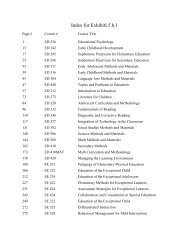Gillian Clark, Christianity and Roman Society - Huntington University
Gillian Clark, Christianity and Roman Society - Huntington University
Gillian Clark, Christianity and Roman Society - Huntington University
You also want an ePaper? Increase the reach of your titles
YUMPU automatically turns print PDFs into web optimized ePapers that Google loves.
124 BOOK REVIEWS<br />
Ian Dowbiggin. A Concise History of Euthanasia: Life, Death, God, <strong>and</strong><br />
Medicine. Lanham, MD: Rowman & Littlefield Publishers, 2005. Pp vii + 161.<br />
$22.95.<br />
Reviewed by Michael A. Flannery, <strong>University</strong> of Alabama at Birmingham /<br />
Ghana Christian <strong>University</strong><br />
As author Ian Dowbiggin, chair of the history department at the <strong>University</strong> of Prince<br />
Edward Isl<strong>and</strong>, points out, current discussion on euthanasia <strong>and</strong> other end-of-life issues<br />
too often is h<strong>and</strong>icapped by “historical amnesia” (152). A necessary corrective is offered<br />
in A Concise History of Euthanasia. In a brief introduction <strong>and</strong> seven compact but lucid<br />
chapters Dowbiggin demonstrates how the permissive views of suicide <strong>and</strong> euthanasia in<br />
classical Greece <strong>and</strong> Rome gave way to the Christian ethic that moved death from human<br />
choice towards God’s will. “By the onset of the sixteenth century,” writes Dowbiggin,<br />
“church, state, society, <strong>and</strong> medicine had forged an alliance that decisively rejected the<br />
taking of life either by suicide or with medical assistance. This durable alliance would<br />
weather the Renaissance, the Reformation, <strong>and</strong> even the Enlightenment, lasting for the<br />
most part down to the early-twentieth century. Only then would the venerable Christian<br />
consensus regarding a good death begin to unravel” (19-20).<br />
And unravel it did. Under the pressures of rising secularism, prompted by Charles<br />
Darwin’s alleged explanation for biological life through natural selection <strong>and</strong> Francis<br />
Galton’s social application with eugenics (a logical corollary to his cousin’s evolutionary<br />
theory), a “right to die” increasingly was cast within a context of individual freedom <strong>and</strong><br />
liberty. Yet, as Dowbiggin persuasively argues, this “freedom” soon was mired in the<br />
dangerous swamp of situational ethics <strong>and</strong> utilitarianism that saw humans as means to<br />
socially construed ends, ends always defined by society’s power elite. This<br />
notwithst<strong>and</strong>ing, historic gains were made through the persistence of euthanasia <strong>and</strong><br />
right-to-die activists that rode the increasing wave of secular humanism facilitated by an<br />
often-complicit liberal Protestantism in the face of a retreating <strong>and</strong> beleaguered Catholic<br />
Church. Those gains were most notably realized in the state of Oregon, the Netherl<strong>and</strong>s,<br />
<strong>and</strong> Switzerl<strong>and</strong>. Interestingly, what the right-to-die movement got for its efforts was not<br />
more liberty but less: less palliative care in jurisdictions permitting physician-assisted<br />
suicide, less clear examples of truly free choice when examined at the case-by-case level,<br />
<strong>and</strong> generally less rather than more careful monitoring <strong>and</strong> reporting of euthanasia. There<br />
is one thing right-to-die advocates did clearly get for their efforts: more infanticide.<br />
Dowbiggin gives the chilling statistic that “8 percent of all Dutch infant deaths resulted<br />
from lethal injections, even though babies obviously cannot ask to be killed” (128).<br />
Dowbiggin’s book shows how dangerous it is leave questions of life <strong>and</strong> death to<br />
human decision-makers unmediated by a higher moral <strong>and</strong> ethical law. In the end, who is<br />
the arbiter of matters of life <strong>and</strong> death, man or God? For Christians, the Apostle Paul<br />
answered this most definitively in <strong>Roman</strong>s 14:7-8. The American Medical Association<br />
understood this when it elected to adopt Thomas Percival’s Medical Ethics (1803) for its<br />
own code in 1847. It would be another century before the AMA would substantively
















